NASA Orion spacecraft blasts off atop 1st Space Launch System rocket in 2017 – attached to European provided service module – on an ambitious mission to explore Deep Space some 40,000 miles beyond the Moon, where an asteroid could be relocated as early as 2021. Credit: NASA
Story updated with further details[/caption]
NASA managers have announced a bold new plan to significantly alter and upgrade the goals and complexity of the 1st mission of the integrated Orion/Space Launch System (SLS) human exploration architecture – planned for blastoff in late 2017.
The ambitious first flight, called Exploration Mission 1 (EM-1), would be targeted to send an unpiloted Orion spacecraft to a point more than 40,000 miles (70,000 kilometers) beyond the Moon as a forerunner supporting NASA’s new Asteroid Redirect Initiative – recently approved by the Obama Administration.
The EM-1 flight will now serve as an elaborate harbinger to NASA’s likewise enhanced EM-2 mission, which would dispatch a crew of astronauts for up close investigation of a small Near Earth Asteroid relocated to the Moon’s vicinity.

Until recently NASA’s plan had been to launch the first crewed Orion atop the 2nd SLS rocket in 2021 to a high orbit around the moon on the EM-2 mission, said NASA Associate Administrator Lori Garver in an prior interview with me at the Kennedy Space Center.
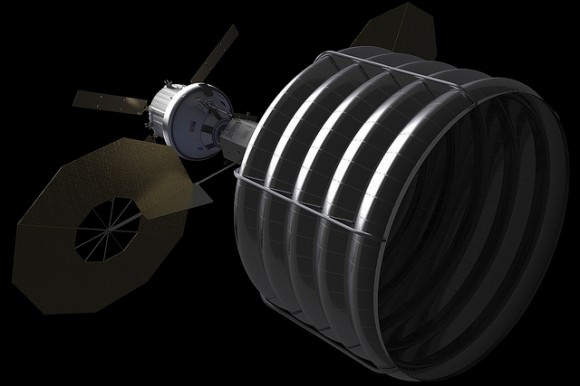
The enhanced EM-1 flight would involve launching an unmanned Orion, fully integrated with the Block 1 SLS to a Deep Retrograde Orbit (DRO) near the moon, a stable orbit in the Earth-moon system where an asteroid could be moved to as early as 2021.
Orion’s mission duration would be nearly tripled to 25 days from the original 10 days.
“The EM-1 mission with include approximately nine days outbound, three to six days in deep retrograde orbit and nine days back,” Brandi Dean, NASA Johnson Space Center spokeswoman told Universe Today exclusively.
The proposed much more technologically difficult EM-1 mission would allow for an exceptionally more vigorous work out and evaluation of the design of all flight systems for both Orion and SLS before risking a flight with humans aboard.
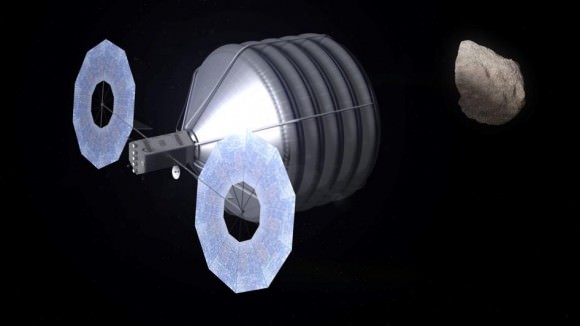
A slew of additional thruster firings would exercise the engines to change orbital parameters outbound, around the moon and inbound for reentry.
The current Deep Retrograde Orbit (DRO) plan includes several thruster firings from the Orion service module, including a powered lunar flyby, an insertion at DRO, an extraction maneuver from the DRO and a powered flyby on return to Earth.
Orion would be outfitted with sensors to collect a wide variety of measurements to evaluate its operation in the harsh space environment.
“EM-1 will have a compliment of both operational flight instrumentation and development flight instrumentation. This instrumentation suite gives us the ability to measure many attributes of system functionality and performance, including thermal, stress, displacement, acceleration, pressure and radiation,” Dean told me.
The EM-1 flight has many years of planning and development ahead and further revisions prior to the 2017 liftoff are likely.
“Final flight test objectives and the exact set of instrumentation required to meet those objectives is currently under development,” Dean explained.
Orion is NASA’s next generation manned space vehicle following the retirement of NASA’s trio of Space Shuttles in 2011.
The SLS launcher will be the most powerful and capable rocket ever built by humans – exceeding the liftoff thrust of the Apollo era Moon landing booster, the mighty Saturn V.
“We sent Apollo around the moon before we landed on it and tested the space shuttle’s landing performance before it ever returned from space.” said Dan Dumbacher, NASA’s deputy associate administrator for exploration systems development, in a statement.
“We’ve always planned for EM-1 to serve as the first test of SLS and Orion together and as a critical step in preparing for crewed flights. This change still gives us that opportunity and also gives us a chance to test operations planning ahead of our mission to a relocated asteroid.”
Both Orion and SLS are under active and accelerating development by NASA and its industrial partners.
The 1st Orion capsule is slated to blast off on the unpiloted EFT-1 test flight in September 2014 atop a Delta IV Heavy rocket on a two orbit test flight to an altitude of 3,600 miles above Earth’s surface.
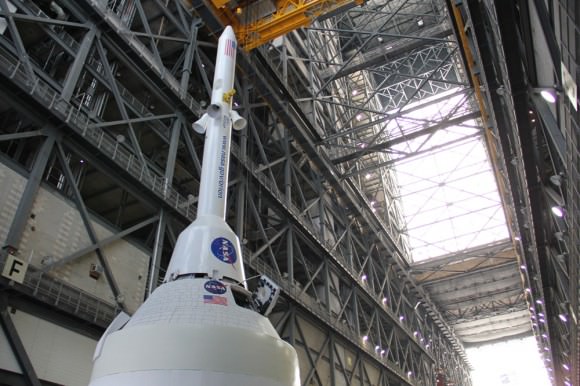
It will then reenter Earth’s atmosphere at speeds of about 20,000 MPH (11 km/sec) and endure temperatures of 4,000 degrees Fahrenheit in a critical test designed to evaluate the performance of Orion’s heatshield and numerous spacecraft systems.
Orion EFT-1 is already under construction at the Kennedy Space Center (KSC) by prime contractor Lockheed Martin – read my earlier story here.
Integration and stacking tests with Orion’s emergency Launch Abort System are also in progress at KSC – details here.
NASA says the SLS is also in the midst of a extensive review process called the Preliminary Design Review (PDR) to ensure that all launch vehicle components and systems will achieve the specified performance targets and be completed in time to meet the 2017 launch date. The PDR will be completed later this summer.
NASA’s goal with Orion/SLS is to send humans to the Moon and other Deep Space destinations like Asteroids and Mars for the first time in over forty years since the final manned lunar landing by Apollo 17 back in 1972.
NASA Headquarters will make a final decision on upgrading the EM-1 mission after extensive technical reviews this summer.
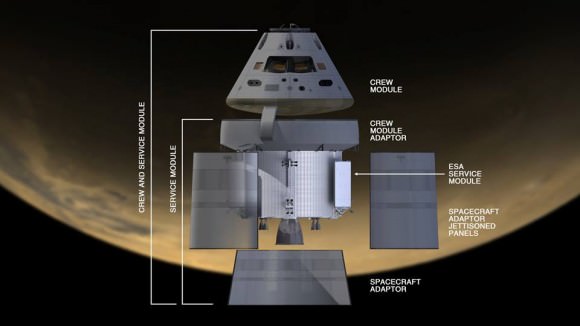

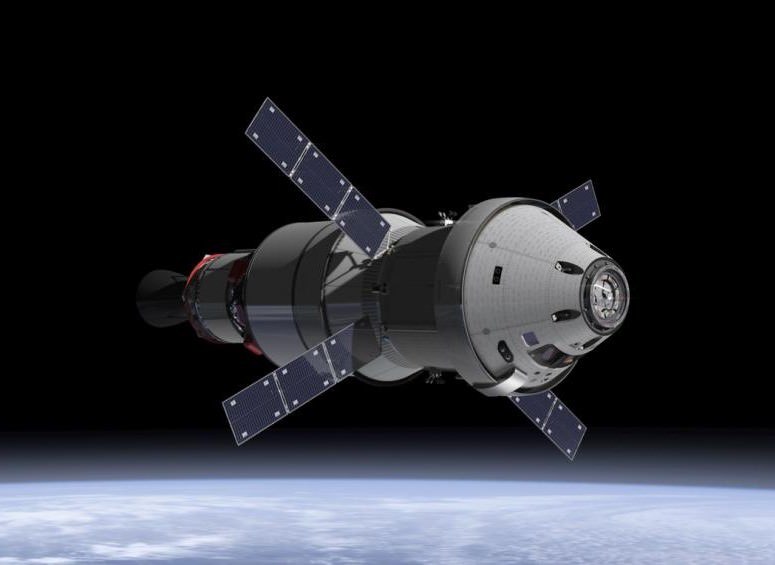
I like the aggressive test approach but fear it’s really just a PR stunt to keep support for this boondoggle that’s sapping funds from space science
So putting space craft in space is sapping funds from space science?
Huh?
building & flying manned spacecraft is not science
Yes it is:- Material Science, Metallurgy AND Welding, Computer Science,
Advance Development and Manufacturing of new materials……… and on and on
and on, naive and unfounded comment.
That’s really more engineering than science.
Engineering physics or engineering science degrees are respected academic degrees awarded in many countries. It is notable that in many languages the term for “engineering physics” would be directly translated into English as “technical physics”. In some countries, both what would be translated as “engineering physics” and what would be translated as “technical physics” are disciplines leading to academic degrees, with the former specializes in nuclear power research, and the latter closer to engineering physics.[5] In some institutions, engineering (or applied) physics major is a discipline or specialization within the scope of engineering science, or applied science.
Once again a pork barrel jobs program pretending to be a “space program” is sucking up massive funding from NASA greatly cutting space science and planetary science missions. Like the ill fated ARES and X-33 boondoggles that wasted billions with zero test flights, the SLS is another congressional district jobs program.
I assumed informed readers here knew the basic difference between engineering, technology development and pure science (Hubble, WMAP, Curiosity, etc.) I was wrong.
Regardless of the definition most everyone around here would rather have that money spent on:
a. Telescopes
b. Rovers/orbiters
c. Extended missions/upgrades for current telescopes & rovers.
As for the engineering of new rockets and spacecraft the private sector can do it faster, cheaper, and better than gov’t can.
With no SLS/Orion et al. More of the military/industrial complex would get involved and we’d wind up with something really cool.
Scientists doing science in space is science.
Putting manned spacecraft in space is technology, not science. It’s an engineering accomplishment, but it yields relatively little knowledge about anything other than the performance of the spacecraft itself (a craft intended to carry humans). By now it’s well established that, dollar for dollar, robots yield much more knowledge about the solar system than manned spacecraft do. Even the International Space Station yields relatively little data about anything other than the human response to space flight — along with some observational earth studies that could be done just as well (and far more cheaply) with robots. In contrast, the orbiting space telescopes and robotic Mars rovers have yielded a treasure trove of data that will keep scientists busy for decades.
The problem is that putting so much money into crewed spaceflight without an inspiring short-term goal takes away from planetary science, cosmology, educational outreach, etc. For the amount we are spending on Orion we could have numerous really exceptional unmanned missions and new scientific instruments.
I am not opposed to human space exploration in theory, but it has to be done in such a way that it inspires. That’s really the only benefit of crewed spaceflight. Currently the goal of our underfunded crewed spaceflight program is a Mars landing some two decades from now…one that is likely to be cancelled, postponed, or changed by future administrations and congresses. And Elon Musk is likely to beat us to Mars, rendering NASA’s program truly pointless.
It is when it costs $3billion per year to develop and it starves funds from less expensive and more effective programs. Commercial crew is being hamstrung and delayed buy cutting its funding and more is being spent on SLS Orion to achieve less.
A spaceX red dragon mission to Mars has an estimated cost of $400million all up. This would achieve more science and cost less than this test flight and help restore US manned access to space at an affordable price.
SLS/Orion is pork, it costs too much and takes too long and achieves too little compared to alternative options.
I find it extremely unlikely that anyone can pull off a manned Mars mission for $400 million. Don’t get me wrong, I’m a huge supporter of Musk and his ambition, I just think his vision and dollars would be better spent creating robotic missions, as it’s pretty apparent we can’t rely on NASA for many meaningful missions going forward given Congress increasingly slashing funding.
Congress is not slashing funding. They’re funding SLS and Orion. The $ comes from space science but sadly even space exploration fans don’t realize this. NASA should do science with the R&D money being spent for SLS, a congressional district jobs for re-election votes boondoggle. Buy launches, including manned from commercial sources.
So I must presume that you live in a cave, swing in trees, use a buggy with a horse and hunt with a spear whilst wearing “war paint”…Oh hang on, you’re using the internet, thus your position is very myopic and hypocritical.
Not to nit-pick, but 40K miles past the moon being called, “Deep Space” is like walking into the ocean up to your ankle and claiming to be in deep water. lol.
I think that will change as we venture deeper into the solar system, but in terms of manned, or man supportable capable, craft then going past the Moon is certainly deep space as the majority of manned missions have not ventured more than about 1000 miles above the surface..
just as Alfred explained I didnt even know that a student can make $5957 in one month on the computer. did you see this site www.KEP2.com
Not impressed with 278,900 miles off the surface of Earth? I wonder if you would be when you got there, realized you were further than anyone had ever been, all the systems (life-support, navigation) had no precedents working on extended missions that far from Earth, and if anything went wrong, you’d be totally f’d, so everything had to work flawlessly.
I’m a space geek too. I want a manned Mars mission more than anyone I know. But it’s hard. Really, REALLY, hard. And a death sentence if all systems don’t work.
I think a better analogy would be that moving out 40K past the moon is like wading up to your hip in the ocean, thinking you know how to swim but never having tried it before, and getting ready to make the plunge.
This sounds like a breathless Public Relations news release, we would expect some comments on the long history of abandoning programs such as Constellation. All of this sounds neat but will we have the money to do it?? Where is the money coming from, what other programs will be cancelled? Lots of hardware was in assembly for Constellation but that gave us no assurance that it would ever be done.
If Dr Kremer is a scientist, might he also mention that this type of asteroid mission was not in our national priorities for exploration?? Dr Kremer might mention that we could do all of this far more safely using robotic missions??
It is in US priorities for exploration according to the proposal of the Augustine review that followed from the failure of Constellation to be affordable, a proposal that the current administration has adopted with little change. [ http://en.wikipedia.org/wiki/Flexible_path ]
Btw, Constellation wasn’t abandoned, it was driving NASA into bankruptcy because it was more ill founded than most boondoggles. Hence the new, more affordable program. But make no mistake, being affordable doesn’t mean useful. We all know SLS is the new “as-large-a-Constellation-program-that-tax-payers-allows-us-to-get-away-with” Big F-ing (“Fuel-consuming”) Rocket.
While trying to be polite, did you notice that in the Wikipedia article that you point to, no where is asteroid mentioned?
And if Constellation was not abandoned, is there a better word that you could suggest that means “not being done, and the entire program was cancelled”? Now large parts of Constellation continue still – under different names. But that was due to the Senate refusing to allow the Administration to cancell the program.
Some input from real scientists:
http://news.sciencemag.org/scienceinsider/2013/07/nasa-warned-to-go-slow-on-astero.html
“The SLS launcher will be the most powerful and capable rocket ever built by humans – exceeding the liftoff thrust of the Apollo era Moon landing booster, the mighty Saturn V.”
Not until later versions. The one that will fly in 2017 will have much lower liftoff thrust, though still impressive. It’ll beat out Falcon Heavy by a big margin and will be well more than double the next biggest contender in service (I believe Delta IV, but I might be missing one). That said, the Saturn V talk is in regards to a Mark II vehicle which is not likely to fly until the mid 2020’s at the earliest, and frankly I have my doubts it’ll ever fly. I have some minimal level of doubt Mark I will fly more or less fly on time, but at least that one stands a pretty solid chance of it.
To jump on the cynical bandwagon, I suspect Mark II exists on paper to pacify Shelby, et al, who demanded a 130t to LEO vehicle that NASA never requested and has stated they don’t need. Some significant murmurings are starting to eek out about it not ever being an essential piece of the puzzle. In other words, we don’t need it and are going to avoid building it until we absolutely have to in hopes it’ll just go away.
Yes it is still science. The science of keeping those humans alive and observe how they act in deep space.
Apparently you can’t read. I acknowledged that part. I said (above) that the ISS “yields relatively little data about anything other than the human response to space flight.” The problem is that ‘s the only pure science the ISS really does. Other kinds of pure science can be done far more cost-effectively with robots. That’s the point that matters here — not quibbles over semantics.
Ambition. Good.
I have an engineering question.
Those 4 extended solar panels.
Won’t that create additional stress when they fire the main engine?
Don’t get me wrong, I’m 100% in tabor of anything that puts us closer to exploring and colonizing the solar system.
I just wish we didn’t have to take at one time; both the most expensive and least efficient path to get there.
Although it seems that’s the only way anything gets done in a democracy.
I’m sorry but saying that the private sector can build rockets cheaper is a very short sighted statement.
All you need to do is look at any tech company to see how the private sector will wring every last cent of profit out of technology to make as much profit as possible.
If it wasn’t for government demand for faster, more powerful engines for military aircraft propeller driven aircraft would still be the norm and we would still spending weeks to travel across the oceans on cruise liners.
If it wasn’t for Government demand for better ways to spy on other countries, communicate with the military and attack other countries, the V2 would be the peak of human rocketry.
The only reason the private sector ever gets involved in something is when they see a profit in it for them. And once they start to make a profit they will squeeze every last cent out of their research dollar.
If the government had started researching computer technology properly in the 60s and kept researching, we would have had quantum computers a decade ago.
Left to the private sector, basic medicine would only be available to the richest of the rich, and there would be on research into better drugs with fewer side effects.
In short, I’m glad with the fact that the government gets involved in research. I shudder to think where we would be without it.
The funny thing is that you just made my point far better than I ever could have!
The gov’t doesn’t make those spy satellites private companies like Orbital Sciences and Northrop Grumman Corp do.
The gov’t also doesn’t make those jet planes you mentioned private companies do like Boeing and Lockheed Martin do.
Now to get to the point we are at today with Orion & the SLS uncle Sam has forked out OVER 13 BILLION DOLLARS!!!
What have we received for that money you ask?
Good question! So far we have a capsule, kinda. I mean it is a capsule and the fact that it won’t get closer to space than the average jet plane till the END OF 2014!!! If we are very, very lucky!
Oh yeah it’s gunna use a Atlas rocket for that trip btw. Now lets compare and contrast to Spacex.
As of May 2012 SpaceX had spent $1.2 billion of public and private money. That includes the Dragon Capsule, Falcon rocket and they have already been to space and the ISS and back.
Oh yeah they also started 2 years AFTER Orion et al 2006 opposed to 2004.
So in what kind of an alternate dimension does it make sense to have a giant govt bureaucracy do this?
Btw SLS should make its 1st launch in 2017. Elon Musk flat out said for 4 billion he’ll put us back on the moon by then.
I think that if you re-read what I posted, you will see that not once did I say that the government made them. I said that the governement demanded them and spent the money to make them a reality.
If the government didn’t ask these private companies to make these things, and pay them to do it, do you really think they would have spent the money to invent these things off their own bat? For the benefit of humanity? Hell no.
The only reason these things exist today is because the government wanted them to exist. Boeing and Lockheed would never have invented a jet engine if the government didn’t ask them to.
It doesn’t matter who builds it. It doesn’t matter who designs it, It only matters who creates demand. Who wants to take something out of the dream and but it into the real world.
The private sector is much better at product development and manufacturing that the government. Building conventional rockets is product development not basic research. The SLS is just product development not basic research. In fact the rocket that comes closest to basic research is Grasshopper/Falcon reusability and Falcon Heavy with cross feed. Oh that is being done by a Private company without any government funding for those projects.
Private companies develop what they think will make money, look at the development of tablets and smartphones. Done by private companies for profit. Some of the technology started form government research but most of it was private development.
Again, I never said that the government had any thing to do with development or design or building any thing at all. I said, if you will read again, that the government created demand. The government went to these companies and said “we want to do this thing” the companies said “OK, we’ll see what we can do”.
Untill the government asked for them, there was no need and so none bothered to try, because there is no market for it.
Tony, I see your point, but SpaceX differs in large part due to the fact that the stated goal of the company has been, since its inception, to put people on Mars and Musk has been pretty clear that it is still a goal of the company. Indeed, recent comments make it clear they will not be making a public stock offering until they are able to put people on Mars because an IPO would introduce standard bottom-line business interest into the company and would likely prevent such long-term goals. So this isn’t a standard publicly traded Boeing or LockMart business approach, and shouldn’t be treated that way.
All that said, it is a company with limited resources and it absolutely has to make money or the long-term goals won’t be achieved. Musk is a rich man as are the members of the Founder’s Fund, but all of them combined aren’t enough to float the entire venture without paid business. And yes, they will try to get the most money for their work and their product as possible. And yes, much of that business is currently government work (though that portfolio is quickly diversifying into private launches).
But they announced Dragon before COTS existed and certainly before a manned capability was part of the NASA equation. They built Falcon 9 from the blueprints up with the idea that a crew would eventually be on board and even did systems testing on Falcon 1 to that end, though that rocket was never, itself, intended to be manned. The reusable Falcon 9 variant? No one’s asking for that and no contract exists for it. But if it works, you better believe SpaceX will sell more launches and improve their bottom line. Falcon Heavy started cutting metal before any interest was expressed in a rocket of its size, and is near completion today, despite having only a handful of paid customers. And the new engine variants, the talk of Falcon X, etc, none of that has a government contract backing it or even commercial demand. In fact it has been one of the biggest criticisms from SpaceX’ detractors for some time (where’s the market for this?).
The old guard never even made a blueprint unless NASA, USAF, et al asked for it. And even today the Boeing CST-100 and Orion only exist because a contract was on the table already for them to compete for. That is not as much the case for Blue Origin or Sierra Nevada who started their projects before such contracts existed, and not the case at all for SpaceX, who continues to push technological advances with no immediate payoff in the form of a potential contract.
So your critique isn’t entirely without merit. SpaceX can’t be a company without customers and it needs to make the best profits it can from those contracts. But SpaceX’s approach has in no way been contract driven. Their contracts have always been a means to an end.
And that makes them the exception to the rule. But the human species push into the solar system and then the Galaxy can not and should not be left in the hands of a single organization.
Yeah, and I’ve been holding out hope that someone else will stand out from the crowd in a SpaceX sort of way. I hold out some hope with Blue Origin in that they seem to be pushing the envelope in ways their contracts don’t necessarily demand, but they are so hush hush it’s hard to know what we’re getting with them. I’m sure NASA knows, and we get little tidbits whenever they are legislatively required to do so, but it’s good for hope and not a lot else. When it comes down to it, what SpaceX has done has literally never been done before. I’d love to see more players on the field that work like they do, but it’s a pure luck-shot we got them. This is me crossing my fingers.
I must presume that you sadly lack reading skills
I am sure my skills exceed that of yourself, but our respective reading skills are not the point here, the point is that NASA has a job to do and are doing it the best way they know. They are absolutely paranoid about losing an astronaut on a mission and they are simply taking things slowly to ensure all systems work flawlessly. You clearly have a myopic view of this whole process and your opinion is clearly in the minority.
The Apollo missions were manned.
Just set aside $20 billion for a Mars Prize and let the private sector compete to get there. NASA has so wasted taxpayer money on pointless stuff over the last few decades that I’d much rather see big space done that way than the government micromanaging everything.
Majority opinion is not the issue. NASA has done an awful job in manned spaceflight since Apollo & Skylab in the 70s. One failed development after another, X-33 never flew $1B, Constellation POGO problems never flew and now the SLS jobs program boondoggle that eats funds for space science. Too bad the majority of space cadets worship NASA uncritically.